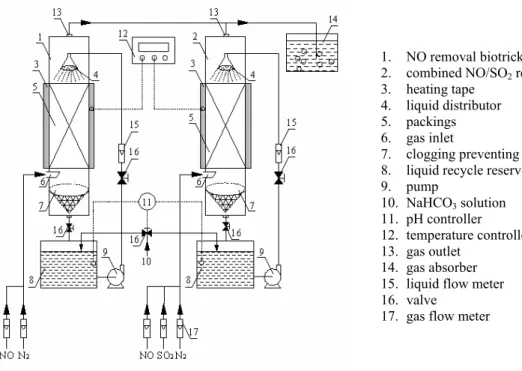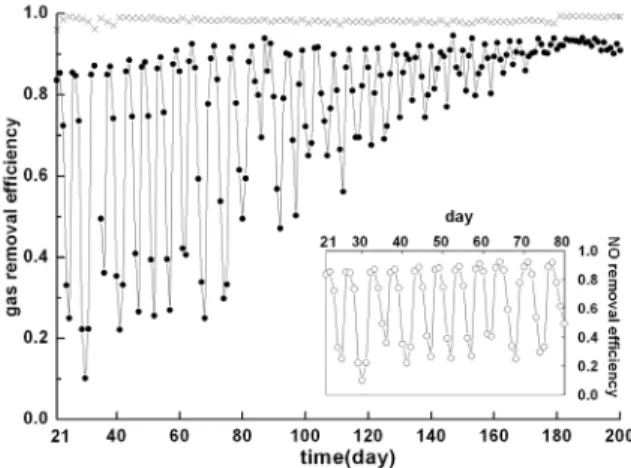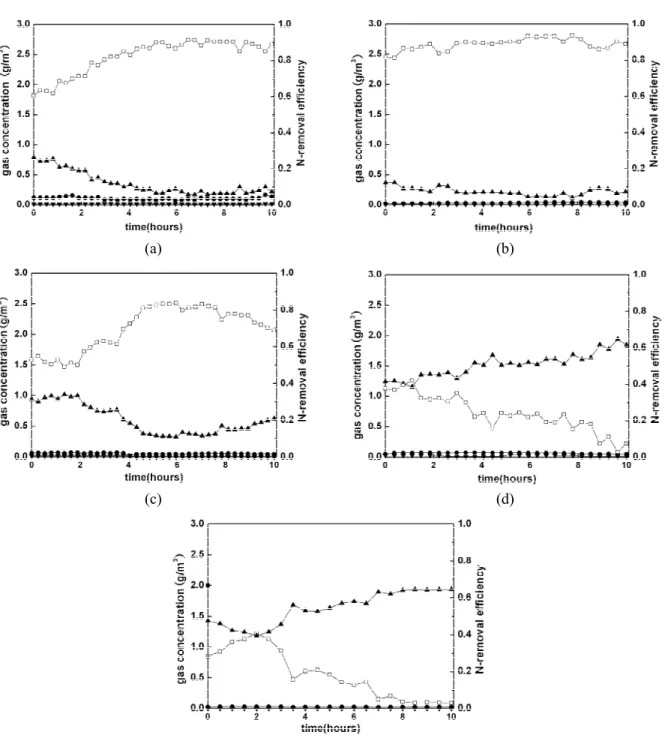ISSN 0104-6632 Printed in Brazil
www.abeq.org.br/bjche
Vol. 28, No. 02, pp. 189 - 196, April - June, 2011
*To whom correspondence should be addressed
Brazilian Journal
of Chemical
Engineering
A PERFORMANCE STUDY OF SIMULTANEOUS
MICROBIAL REMOVAL OF NO AND SO
2
IN A
BIOTRICKLING-FILTER UNDER ANAEROBIC
CONDITION
Yaqiong Han, Weijiang Zhang
*and Jiao Xu
School of Chemical Engineering and Technology, Tianjin University, Phone: +86-13642014092, Fax: +86-22-58299574, Tianjin 300072, China.
E-mail: *zzw@tju.edu.cn; hanyaqiong@tju.edu.cn; xujiaohh@sohu.com
(Submitted: August 27, 2010 ; Revised: November 3, 2010 ; Accepted: November 22, 2010)
Abstract - The behaviors of simultaneous removal of NO and SO2 using the coculture of anaerobic
denitrifying bacteria and sulfate reducing bacteria was investigated in a bench-scale biotrickling-filter. When the combined NO/SO2 removal biotrickling-filter was operated at an empty bed residence time of 76 s with
NO and SO2 feed concentrations of 2 and 2 g/m3, respectively, the SO2 removal efficiency was always above
95%, while NO removal exhibited an evident periodicity of 5-6 days for the initial 60 days after the attachment phase. A steady-state NO-removal efficiency of around 90% was obtained after 130 days of continuous operation. Experimental results indicated that the coculture in the combined NO/SO2 removal
biotrickling-filter showed a higher resistance to shock NO-loadings and a better tolerance to starvation than the single denitrifying bacteria in the NO removal biotrickling-filter.
Keywords: Simultaneous removal of NO and SO2; Coculture; Anaerobic denitrifying bacteria; Sulfate
reducing bacteria; Biotrickling-filter.
INTRODUCTION
The removal of nitrogen oxides (NOx), consisting of ±95% nitric oxide (NO) and ±5% nitrogen dioxide (NO2) (Flanagan et al., 2002), and sulfur oxides (SO2) emitted from stationary combustion facilities has been required to protect the atmospheric environment (Sadaet al., 1980). So far, a number of integrated processes for simultaneous removal of NO and SO2 have been developed, such as electron beam treatment (EBA), pulsed corona induced plasma chemical process (PPCP), combination of flue gas desulfurization (FGD) plus selective catalytic reduction (SCR) and absorption. The absorbents include activated carbon(Zhu et al., 2005), CuO/γ -Al2O3 (Jeong and Kim, 2000), Ca-pellets+K/Carbon-pellets (Bueno and Garcia, 2005), etc. EBA
Brazilian Journal of Chemical Engineering
production of the by-product gypsum and the advanced wastewater treatment required before discharging (Zhao et al., 2005). With respect to the absorption technique, a major disadvantage is the cost associated with the replacement or regeneration of the exhausted carbon and other absorbents (Hutchinson and Robinson, 1990). Therefore, there has been an increasingly urgent need for a simple, low-cost and single-stage treatment used for simultaneous removal of SO2 and NO.
Simultaneous bioremoval of SO2 and NO is considered to be as a promising alternative technique due to the reasons of temperature, low-consumption, low-cost, simplicity of operation and no secondary pollution. As early as 1991, Lee and Sublette (2001) proposed the concept of combined removal of SO2 and NO using mixed cultures of
Desulfovibrio desulfuricans (a sulfate-reducing
bacteria) and Thiobacillus denitrificans (an autotrophic denitrifying bacteria). They also demonstrated that simultaneous removal of SO2 and NO could be realized by the coculture of sulfate-reducing bacteria (SRB) and anaerobic denitrifying bacteria (ADB) (Dasu et al., 1993), but they did not further investigate the combined removal performance under different conditions. Philip and Deshusses (2003) utilized activated sludge as the inoculum instead of specific bacterial strains to make the operation economically viable, however, they focused more on the complete treatment of SO2 and ignored the combined removal behaviors. In the present study, simultaneous removal of SO2 and NO using the coculture of SRB and ADB in a bench-scale biotrickling-filter is described. Both SRB and ADB were enriched from landfill leachate, which was initially inoculated into the filter. A comprehensive study of the long-term bioremoval performance was conducted under the selected operating conditions. In order to compare the NO removal performance, a parallel test using the single denitrifying bacteria to remove NO-rich gas was also carried out.
MATERIAL AND METHODS
Biotrickling-Filter Setup and Operation
A schematic of the experimental setup is shown in Fig. 1. The NO removal biotrickling-filter (NRBF) and the combined NO/SO2 removal biotrickling-filter (CRBF) were operated in parallel to make a comparison of NO-removal performance between the single denitrifying bacteria and the coculture. Each biotrickling-filter (BF) was made of acrylic. The total height of each BF was 200 cm with an inner diameter
of 8 cm and a bed depth of 150 cm. Each BF was filled with polyethylene Cascade Rings (25×13×1 mm; specific surface area of 228 m2/m3; bulk density of 65 kg/m3). Additionally, each one was operated at a constant temperature (30±0.5°C) with the heating tape which was controlled by a digital temperature controller (AI-708P, China). The pH of the recirculation liquid in each reservoir was controlled at 7.0±0.1 via a pH controller (Knick model 761, Germany) that automatically added 5 wt% NaHCO3 solution to the liquid. The gas was fed to each BF from the bottom, while the nutrient liquid was supplied at a rate of 100 L/h from the top. SO2, NO and N2 contained in the feed gas were supplied from compressed gas cylinders and then mixed in a gas mixer before entering the filter (not shown in Fig. 1). The fluxes of SO2, NO and N2 were controlled by the gas flow meters. In each biotrickling-filter, the carrier gas (N2) flow rate was controlled to keep a constant empty bed residence time (EBRT) of 76 s.
The landfill leachate used for seeding the filter was obtained from a municipal landfill in Tianjin, China. Prior to being filled to the filter, the packings were soaked in the landfill leachate for one week to facilitate bacterial attachment to the surface of the packing materials. Then each BF, filled with the pre-soaked packing materials, was supplied with 1 L of landfill leachate and 10 L of the respective selective medium (as shown in Table 1). Neither nitrate nor sulfate was contained in the medium to acclimate the microorganisms to NO or SO2 as a terminal electron acceptor for ADB or SRB. In order to ensure that the filter was anoxic, each BF was flushed with N2 until the gas phase had been exchanged 20 times (Belleret al., 1996). The pumps were then started and allowed to work continuously under anoxic conditions. For each BF, half of the liquid was replaced weekly by fresh medium for the initial 20 days and then the whole liquid was removed and replaced weekly by an equal volume of fresh medium for the next 196 days, because the substrates of ammonium, thiosulfate and lactic acid were basically depleted within a week. The continuous measurements were conducted between 8:00 and 18:00 everyday. The specific operating conditions are shown in Table 2.
Analyses
Brazilian Journal of Chemical Engineering Vol. 28, No. 02, pp. 189 - 196, April - June, 2011
water quality analyzer (Merck NOVA 60 Spectroquant, Germany). The concentration of lactic acid was determined using a commercial lactic acid assay kit (Nos 330-1, Sigma). The number of SRB cells was measured by using fluorescence in situ hybridization (FISH) method with the SRB385 probe (Zhang et al., 2008). The number of ADB cells was
measured by combined use of stable-isotope probing (SIP), full-cycle rRNA analysis and FISH (Ginige et al., 2005). The packing materials with a homogeneous biofilm cover used for cell measuring were taken out of the reactor randomly. More detailed descriptions of the preparations for FISH analysis are provided by Ramsing et al (1993).
1. NO removal biotrickling-filter
2. combined NO/SO2 removal biotrickling-filter
3. heating tape 4. liquid distributor 5. packings 6. gas inlet
7. clogging preventing net 8. liquid recycle reservoir 9. pump
10. NaHCO3 solution
11. pH controller 12. temperature controller 13. gas outlet
14. gas absorber 15. liquid flow meter 16. valve
17. gas flow meter
Figure 1: Schematic diagram of the experimental setup
Table 1: Medium composition of anaerobic denitrifying bacteria (A) in NRBF and coculture (B) in CRBF
Substrates A
(g/L)
B (g/L)
NH4Cl 1 1
KH2PO4 0.05 0.05
K2HPO4 0.2 0.2
Thiosulfate 5 0
lactic acid 0 3.5
ascorbic acid 0 0.1
yeast extract 0 1
NaHCO3 2.52 2.52
FeSO4⋅7H2O 0.05 0.05
trace elements* 0.02 0.02
*
Trace elements: Cu2+ , Co2+
, Mn2+ , Zn2+
, Ca2+
and ammonium molybdate
Table 2: Operation sequence and conditions
Feed gas of NRBF Feed gas of CRBF
Day Description NO
(g/m3)
NO (g/m3)
SO2 (g/m3)
1-20 Attachment phase 0.50-2.02 0.49-2.05 0.45-2.07
21-200 Long-term acclimation 1.99-2.05 2.01-2.08 2.02-2.04
201-202 NO-shock loadings a a 2.03-2.06
203-204 Recovery from shock loadings 2.03-2.05 2.00-2.06 2.01-2.08
205-210 Starvation-survival 0 0 0
211-216 Recovery from starvation 2.01-2.04 2.01-2.05 2.02-2.06 a
On Day 201 and Day 202, NO feed concentrations at the 1.5th and 5.5th
Brazilian Journal of Chemical Engineering RESULTS AND DISCUSSION
The aim of this study is to develop a biological treatment for simultaneous removal of NO and SO2 using a single biotrickling-filter. A 216-day continuous experiment was conducted to investigate the performance for simultaneous removal of NO and SO2. In order to compare NO-removal stability, the ability of CRBF to resist performance deterioration (i.e., NO-shock loadings and no gas feeding) was compared with NRBF.
Process of Combined Removal of NO and SO2
Simultaneous removal of NO and SO2 can be achieved using the coculture of anaerobic denitrifying bacteria and sulfate reducing bacteria in an attached biofilm bioreactor under anaerobic conditions. In this process, SO2 was first reduced to H2S by SRB; H2S then served as an electron donor for the reduction of NO to N2 in denitrification by ADB. Sulfate produced from H2S oxidation by ADB served in turn as an electron acceptor for the growth of SRB.
SRB obtained the competitive growth advantage prior to ADB and then ADB gradually became co-dominant with SRB (described in detail later in 3.2), which is inconsistent with the previous observation that heterotrophic denitrifying bacteria (hDB) can outcompete SRB for organic electron donors under anaerobic conditions (Gevertz et al., 2000; Hubert and Voordouw, 2007). Heterotrophic denitrifying bacteria did not outcompete SRB, probably due to the absence of nitrite, because nitrite is a strong inhibitor of SRB and hence considered to be the key factor for successful competition of hDB with common organic electron donors (Hubert and Voordouw, 2007). Moreover, continuous H2S production by SRB and insufficient organic carbon caused autotrophic denitrifying bacteria to dominate over heterotrophic denitrifying bacteria. Thus, H2S produced by SRB served as the primary electron donor for NO reduction by ADB, which is quite consistent with the experimental results discussed later. Furthermore, the coculture was acclimated to utilizing NO and SO2 as the terminal electron acceptor by the long-term exposure to a gas mixture of NO, SO2 and N2 (carrier gas). Thus, the capacity of coculture for simultaneous removal of NO and SO2 can be improved gradually with time.
Long-Term Performance of Combined Removal
of NO and SO2
For the initial 20 days, the concentration of NO (or SO2) in the feed gas was increased stepwise to
acclimate ADB (or SRB) to utilizing NO (or SO2) as the terminal electron acceptor. A biofilm was developed on the surface of the packing material shortly after the startup of CRBF. The color of the attached biofilm in the CRBF gradually became dark brown and the off-gas had a strong hydrogen sulfide odor after approximately 6 to 7 days, indicating the successful enrichment of fast-growing SRB from the landfill leachate. These observations were consistent with the FISH-analysis of SRB, in which 1.5×109 cells/mg prot accounted for at least 80% of the coculture. During the next fortnight, however, the color gradually faded to light brown and the odor gradually disappeared; meanwhile, the outlet concentration of SO2 was always below 0.1 g/m3. Estimates from FISH-analysis of the fractions of SRB and ADB were 50% (±15%) and 40% (±15%), respectively. All the above indicated that the coculture of SRB and ADB was successfully enriched from landfill leachate. By contrast, the time required for the development and acclimatization of ADB in NRBF was 7 to 9 days longer than that of CRBF, probably because SRB helped to shorten the startup time of ADB in the CRBF.
After this attachment phase, continuous 180-day (Day 21 to Day 200) measurements of removal efficiencies of NO and SO2 were initiated, which are shown in Fig. 2. It can be concluded that, when both SO2 and NO were fed at a constant rate of 2 g/m3, the SO2 removal efficiency was always above 95%, while NO removal exhibited an evident periodicity of 5-6 days for the initial 60 days (Day 21 to Day 80) after the attachment phase. However, the periodic fluctuation range gradually decreased until a steady-state removal of NO was reached after 130 days (Day 130 to Day 180) with a NO-removal efficiency of around 90%.
Figure 2: Long-term experiments on NO removal
Brazilian Journal of Chemical Engineering Vol. 28, No. 02, pp. 189 - 196, April - June, 2011
From a typical cycle as shown in Fig. 3, the daily N-removal (NO+NO2; NO2 is a result of partial oxidation of NO by trace oxygen existing in the N2) efficiency showed first a progressive increase and then a decrease with time. This phenomenon was particularly obvious in the last 3 days of the cycle. During the first 3 days of the cycle, NOx (NO+NO2) was removed at a relatively
high efficiency and the average daily N-removal efficiencies were 82.8%, 88.4% and 70.4%, respectively (see Fig. 3 (a), (b) and (c)). On the 4th and 5th days, the efficiencies dropped abruptly to below 40% or even approached zero (see Fig. 3 (d) and (e)). However, the removal efficiency on the 6th or 7th day was restored to above 82% (see in Fig. 2).
(a) (b)
(c) (d)
(e)
Figure 3: An entire N-removal (NO+NO2) cycle with the constant NO inlet concentration of 2 g/m3. Time
Brazilian Journal of Chemical Engineering
The possible reason for the daily curved-trend removal as well as the long-term periodic removal may be explained as followed. Nitric oxide reductase, a comparatively very active enzyme, was first induced by the high NO feed to maintain NO at such low concentrations that the potential toxicity of NO was not realized (Goretskiet al., 1990), so that N-removal efficiency gradually increased. However, continuous exposure to such a high NO environment caused the decrease in activity of nitric oxide reductase and hence N-removal efficiency was reduced. After the physiological regulation of the bacteria, the higher NO removal efficiency resumed again. Furthermore, the bacterial tolerance to NO toxicity was gradually enhanced by the long-term acclimatization and so the periodic fluctuation gradually disappeared.
Comparisons of NO Removal Between NRBF and CRBF
The NO removal performances of NRBF and CRBF in response to NO-shock loadings and starvation were evaluated (Fig. 4). When the NO inlet concentration increased to 4.6-4.9 g/m3 from 2 g/m3 on the 1.5th and 5.5th hour of Day 201 and Day 202, the NO outlet concentrations of CRBF suddenly increased to 1.9-2.7 g/m3 from 0.3 g/m3 and then declined to the normal level within 4.5 hours after the NO inlet concentration returned to 2 g/m3. Likewise, the NO outlet concentrations of NRBF returned to the normal level (around 0.5 g/m3) within
4.5 hours after the 1st shock loading. But after the 2nd and 3rd shock loading, NRBF was not capable of resuming the normal efficient removal of NO within 4.5 hours and the average NO-removal efficiencies dropped from 61.3% to 41.6% and 31.5%, respectively. After the 4th shock loading, the time required for NRBF to resume the normal NO-removal efficiency was approximately 21 hours, which was nearly 5 times longer than that for CRBF.
When the high NO-removal efficiency was resumed after NO-shock loadings, gas introduction into each BF was stopped from Day 205 to Day 210 to evaluate the tolerance to a 6-day starvation, which is shown in Fig. 5. The coculture of CRBF could rapidly resume the high NO-removal efficiency within 20 hours after starvation, whereas the single denitrifying bacteria of NRBF showed a poor NO-removal performance for the initial 20 hours after starvation and then resumed its normal removal efficiency after 60 hours.
These results indicated that the ability of CRBF to resist performance deterioration under NO-shock loading or starvation was superior to NRBF. The possible reasons for the superiority of CRBF include: (1) the optimal redox potentials of denitrifying bacteria in CRBF might be prolonged with the aid of SRB (Bailey and Beauchamp, 1971), and (2) heterotrophic SRB contained in CRBF are able to produce slime-like materials that can help to adhere biofilms to the packing surfaces under long-term shear stress (Chou and Lin, 2000).
Figure 4: Comparison of resistance to sudden
NO-shock loadings between CRBF and NRBF. NO feed concentration was kept constant at 2 g/m3 except for the 1.5th and 5.5th hour of Day 201 and Day 202 at 4.6-4.9 g/m3 as indicated by the arrows.
Figure 5: Comparison of restorability between
Brazilian Journal of Chemical Engineering Vol. 28, No. 02, pp. 189 - 196, April - June, 2011 Stoichiometry of Simultaneous Bioremoval of NO
and SO2
For simplification, H2S is assumed to be the sole electron donor for NO reduction to nitrogen by the autotrophic denitrifying bacteria (ADB) under the anaerobic condition. The equations involved in the process are as follows (Zheng et al., 2004):
SRB
2 3 6 3 2 2 2
2SO +C H O ⎯⎯⎯→2H S 3CO+ +H O (1)
ADB 2
2 2 4
4NO+H S⎯⎯⎯→2N +SO −+2H+ (2)
SRB 2
4 3 6 3 2 3
3SO −+2C H O ⎯⎯⎯→3H S 6HCO+ − (3)
The overall equation can be obtained by balancing the electron gain against the electron loss and then summing them up,
coculture
3 6 3 2
2 2 2 2
6NO 2C H O 2SO
3N 2H S 6CO 4H O
+ + ⎯⎯⎯⎯→
+ + + (4)
Table 3 gives the measured ratios of NO consumed to H2S produced with the different feed gas compositions. The ratios were in good agreement with the stoichiometric value of 3 according to Eq. (4) except for the data on the 30th day. One explanation for the positive deviation from the stoichiometric value is that part of the NO was reduced by heterotrophic denitrifying bacteria using lactic acid as the electron donor (Dasuet al., 1993). The ratio of Table 3 approached the stoichiometric value of 3 more closely, indicating that autotrophic denitrification plays an increasingly prominent role in removing NO with H2S as the electron donor and so the assumption is reasonable. In the present study, the NO/SO2 ratio in the feed gas was always lower than the stoichiometric ratio of 3 in order to achieve the maximum NO-removal efficiency. Furthermore, the outlet gas of CRBF containing 0.429-0.657 g/m3 H2S, together with NO stream, can be introduced into NRBF directly to purify exhaust gas.
Table 3: Ratios of NO consumed to H2S produced
with different feed gas compositions at different stages
Feed gas concentration (g/m3) Day
SO2 NO
NO consumed
(g/m3)
H2S1 produced
(g/m3)
Ratio2
30 0.52 0.49 0.29 0.089 3.69 135 1.59 1.56 1.17 0.40 3.32 178 2.05 2.02 1.80 0.63 3.24 191 2.01 2.07 1.88 0.67 3.18 1
H2S produced is the sum of H2S in off-gas and total sulfide in liquid 2
Ratio (mol/mol) of NO consumed to H2S produced
CONCLUSIONS
An experimental investigation has been conducted to remove NO and SO2 simultaneously from flue gases by the coculture of SRB and ADB in a biotrickling-filter. Approximately 20 days were required for mixed-biofilm development using a landfill leachate as the microbial seed in CRBF. FISH-analysis showed that 50% (±15%) of sulfate reducing bacteria and 40% (±15%) of anaerobic denitrifying bacteria were successfully obtained for simultaneous removal of NO and SO2 in CRBF.
When both NO and SO2 were fed at a constant concentration of 2 g/m3 with a constant EBRT of 76 s, the SO2 removal efficiency was always above 95%, while NO removal exhibited an evident periodicity of 5-6 days for the initial 60 days after the attachment phase. Then the periodic fluctuation range gradually reduced until a steady-state removal of NO was reached after 130 days, with a NO-removal efficiency of around 90%. Moreover, compared with denitrifying bacteria in the NRBF, the coculture in the CRBF had a higher resistance to shock NO-loadings and a better tolerance to starvation. Furthermore, the stoichiometry of simultaneous bioremoval of NO and SO2 in CRBF was obtained, which was in excellent agreement with the measured results.
NOMENCLATURE
SRB sulfate-reducing bacteria ADB anaerobic denitrifying bacteria NRBF NO removal biotrickling-filter CRBF combined NO/SO2 removal
biotrickling-filter
BF biotrickling-filter EBRT empty bed residence time
hDB heterotrophic denitrifying bacteria
ACKNOWLEDGMENTS
This work was supported by the Specialized Research Fund for the Doctoral Program of Higher Education of China (NO. 20090032110019).
REFERENCES
Brazilian Journal of Chemical Engineering
electrodes in saturated soils. Can. J. Soil. Sci., 51, No. 1, 51 (1971).
Beller, H. R., Spormann, A. M. and Sharma, P. K., Isolation and characterization of a novel toluene-degrading, sulfate-reducing bacterium. Appl. Environ. Microbiol., 62, No. 4, 1188 (1996). Chou, M. S. and Lin, J. H., Biotrickling filtration of
nitric oxide. J. Air. Waste. Manage., 50, No. 4, 502 (2000).
Dasu, B. N., Deshmane, V., Shanmugasundram, R., Lee, C. M. and Sublette, K. L., Microbial reduction of sulfur dioxide and nitric oxide. Fuel, 72, No. 12, 1705 (1993).
Flanagan, W. P., Apel, W. A., Barnes, J. M. and Lee, B. D., Development of gas phase bioreactors for the removal of nitrogen oxides from synthetic flue gas streams.Fuel, 81, No.15, 1953 (2002). Gevertz, D., Telang, A. J., Voordouw, G. and
Jenneman, G. E., Isolation and characterization of strains CVO and FWKO B, two novel nitrate-reducing, sulfide-oxidizing bacteria isolated from oil field brine. Appl. Environ. Microbiol., 66, No. 6, 2491 (2000).
Ginige, M. P., Keller, J. and Blackall, L. L., Investigation of an acetate-fed denitrifying microbial community by stable isotope probing, full-cycle rRNA analysis, and fluorescent in situ hybridization-microautoradiography. Appl. Environ. Microbiol., 71, No. 12, 8693 (2005).
Goretski, J., Zafiriou, O. C. and Hollocher, T. C., Steady-state nitric oxide concentrations during denitrification. J. Biol. Chem., 265, No. 20, 11535 (1990).
Hubert, C. and Voordouw, G., Oil field souring control by nitrate-reducing sulfurospirillum spp. that outcompete sulfate-reducing bacteria for organic electron donors. Appl. Environ. Microbiol., 73, No. 8, 2644 (2007).
Hutchinson, D. H. and Robinson, C. W., A microbial regeneration process for granular activated carbon—I. process modeling. Water. Res., 24, No. 10, 1209 (1990).
Jeong, S. M. and Kim, S. D., Removal of NOx and SO2 by CuO/γ-Al2O3 sorbent/catalyst in a fluidized-bed reactor. Ind. Eng. Chem. Res., 39, No. 6, 1911 (2000).
Lee, K. H. and Sublette, K. L., Simultaneous combined microbial removal of sulfur dioxide
and nitric oxide from a gas stream. Appl. Biochem. Biotech., 28/29, 623 (1991).
Liu, T., Zeng, L. K., Shui, A. Z., Wang, H., Liu, P. A., Cheng, X. S. and Liu, Y. C., Present situation of research on combined control of SO2 and NOx in flue gas. Industrial Furnace, 29, No. 4, 12 (2007).
López, A. B. and García, A. G., Combined SO2 and NOx removal at moderate temperature by a dual bed of potassium-containing coal-pellets and calcium-containing pellets. Fuel. Process. Technol., 86, No.16, 1745 (2005).
Philip, L. and Deshusses, M. A., Sulfur dioxide treatment from flue gases using a biotrickling filter-bioreactor system. Environ. Sci. Technol., 37, No. 9, 1978 (2003).
Ramsing, N. B., Kuhl, M. and Jorgensen, B. B., Distribution of sulfate-reducing bacteria, O2, and H2S in photosynthetic biofilms determined by oligonucleotide probes and microelectrodes. Appl. Environ. Microbiol., 59, No. 11, 3840 (1993).
Sada, E., Kumazawa, H., Kudo, I. and Kondo, T., Individual and simultaneous absorption of dilute NO and SO2 in aqueous slurries of MgSO3 with FeII-EDTA. Ind. Eng. Chem. Process Des. Dev., 19, No. 3, 377 (1980).
Wang, Q., Huang, H. T. and Wang, J., Removal of SO2 and NOx by pulsed discharge, Guangdong Chemical Industry, 8, No. 36, 130 (2009).
Zhang, W., Liu, C. Q., Liu, T. Z., Lu, T. and Zhang, L. L., Application of florescence in situ hybridization to detecting Karst mountainous soil sulfate-reducing bacterium, Microbiology, 35, No. 8, 1273 (2008).
Zhao, Y., Ma, S. C., Huang, J. J., Xu, P. Y. and Wang, L. D., Testing study on simultaneous removal SO2 and NOx by flue gas circulating fluidized bed. Proceedings of the CSEE, 25, No. 2, 120 (2005).
Zheng, P., Xu, X. Y. and Hu, B. L., New biological denitrification theory and technology. Science Press, Beijing (2004).




